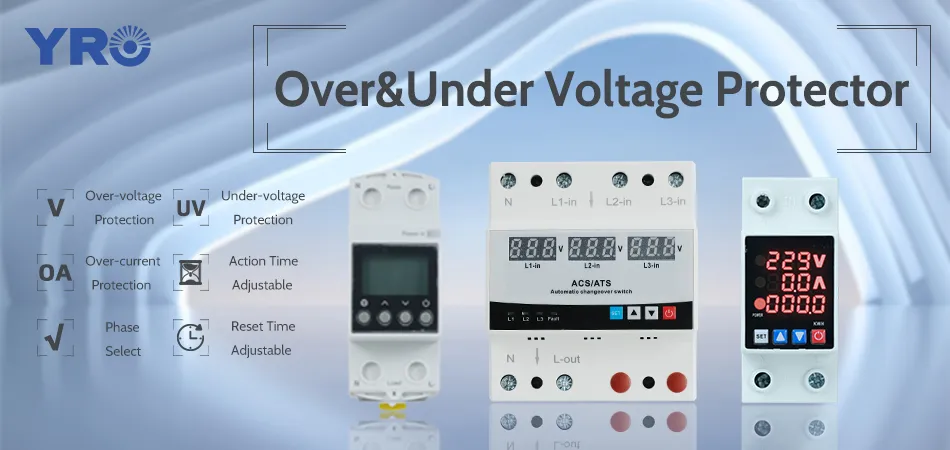What Is an Over and Under Voltage Protector?
2025-05-16
In power systems, voltage abnormalities are one of the main causes of equipment damage and safety hazards. Some people's devices fail to operate properly, while others get burned out—these malfunctions are directly related to voltage issues.
What Is an Over and Under Voltage Protector?
An over/under voltage protector is a protection device that integrates voltage monitoring, logic judgment, and power control. It continuously monitors the supply voltage, and automatically cuts off the circuit when the voltage exceeds or falls below preset safe limits. It then delays auto-reset once voltage normalizes, providing dynamic protection for electrical equipment and power systems. Unlike lightning arresters (which only guard against transient spikes), voltage protectors offer continuous monitoring and comprehensive protection against both high and low voltage conditions.
Despite their importance, many people confuse over and under voltage protectors with lightning arresters. Worse, some underestimate the risks of undervoltage. In the following sections, we'll debunk misconceptions and clarify technical differences.

Can Low Voltage Damage Household Appliances?
Short answer: Yes. While high voltage is an obvious threat, low voltage is a hidden danger. The core mechanisms of undervoltage damage are as follows:
Current Compensation Effect
Most appliances are designed for 220-240V or 110-120V (varies by country).
According to P = V*I, when voltage (V) drops, current (I) increases to maintain power (P). For example:
A 1000W refrigerator compressor (drawing≈4.5A at 220V)
At 180V, current may rise to 1000W / 180V≈5.56A (23% increase)
Voltage fluctuations within ±10% are normal. If they exceed this range, there will be a risk of overheating.
Overheating Hazards
he equipment compensates for power by increasing the current, causing the temperature rise of wires and components to accelerate. The typical manifestations are:
Motor winding insulation degradation (lifespan halves per 10℃rise)
MOSFET failure in power adapters (junction temps >150℃)
Control Logic Failures
When electronic devices are undervoltage, the following may occur:
MCU malfunctions (e.g., a washer mistakenly activating spin mode)
Switch-mode power supplies entering "hiccup mode" (repeated reboots damaging capacitors)
What's the Difference Between a Lightning Arrester and an Over/Under Voltage Protector?
Surge protectors and overvoltage and undervoltage protectors are two complementary but significantly different types of protection devices in power systems. The following is a systematic comparison based on multi-source technical data and practical situations encountered. If there are any errors, please send an email to [email protected] to correct them:
1. Protection Targets & Functions
|
Aspect |
Lightning Arrester (SPD) |
Over and Under Voltage Protector |
|
Primary Threat |
Transient high-energy pulses (e.g., lightning, switching surges) |
Sustained voltage anomalies (e.g., chronic over/undervoltage) |
|
Energy Handling |
Mega-joule transient energy (e.g., 40kA lightning strike) |
Joule-level sustained energy (e.g., 170–275V grid fluctuations) |
|
Damage Mode |
Insulation breakdown, component burnout (nanosecond spikes) |
Overheating, logic failures (minute-level anomalies) |
|
Goal |
Prevent physical destruction from transient surges |
Mitigate performance degradation & lifespan reduction |
2. Operation Mechanisml
- ● Lightning Arrester(SPD)
Uses nonlinear components (e.g., MOVs, gas discharge tubes) to create a low-impedance path within 1–25ns, diverting surge current to ground while limiting residual voltage.
Response time: 1–100ns
Action mode: Passive diversion (parallel connection, no circuit interruption)
- ● Over/Under Voltage Protector
Samples voltage in real-time: if thresholds are breached, a relay cuts power and delays reset post-recovery.
Response time: 1–2 seconds (inverse-time characteristic: faster for severe overvoltage)
Action mode: Active disconnection (series-connected, controls circuit breakage)
3. Application Scenarios
|
Scenario |
Preferred Device |
Reason |
|
Lightning-prone areas |
SPD |
Blocks induced lightning surges |
|
Aging grid systems |
Over and Under Voltage Protector |
Addresses chronic voltage issues from transformer/line decay |
|
Industrial VFDs |
SPD + Over and Under Voltage Protector |
Suppresses drive switching surges + grid fluctuations |
Taking household power distribution as an example, a three-level protection system was designed:

From this, it can be seen that surge lightning protection devices and overvoltage and undervoltage protection devices are complementary: SPD cannot cope with continuous overvoltage in the power grid, and at this time, a voltage protection device is needed to cut off the power supply. The voltage protector has no response to nanosecond-level lightning surges and requires SPD to provide transient protection.
Conclusion
Voltage fluctuations are inevitable, but their damage can be prevented. Overvoltage and undervoltage protectors provide dual protection against overvoltage and undervoltage in a simple and economical way. When used in conjunction with surge arresters, they can achieve a higher level of protection. Whether you are in an area with unstable power grids or simply seek peace of mind, installing overvoltage and undervoltage systems is a long-term beneficial measure.




